Zehuan Yuan
VC-LLM: Automated Advertisement Video Creation from Raw Footage using Multi-modal LLMs
Apr 08, 2025Abstract:As short videos have risen in popularity, the role of video content in advertising has become increasingly significant. Typically, advertisers record a large amount of raw footage about the product and then create numerous different short-form advertisement videos based on this raw footage. Creating such videos mainly involves editing raw footage and writing advertisement scripts, which requires a certain level of creative ability. It is usually challenging to create many different video contents for the same product, and manual efficiency is often low. In this paper, we present VC-LLM, a framework powered by Large Language Models for the automatic creation of high-quality short-form advertisement videos. Our approach leverages high-resolution spatial input and low-resolution temporal input to represent video clips more effectively, capturing both fine-grained visual details and broader temporal dynamics. In addition, during training, we incorporate supplementary information generated by rewriting the ground truth text, ensuring that all key output information can be directly traced back to the input, thereby reducing model hallucinations. We also designed a benchmark to evaluate the quality of the created videos. Experiments show that VC-LLM based on GPT-4o can produce videos comparable to those created by humans. Furthermore, we collected numerous high-quality short advertisement videos to create a pre-training dataset and manually cleaned a portion of the data to construct a high-quality fine-tuning dataset. Experiments indicate that, on the benchmark, the VC-LLM based on fine-tuned LLM can produce videos with superior narrative logic compared to those created by the VC-LLM based on GPT-4o.
UniTok: A Unified Tokenizer for Visual Generation and Understanding
Feb 27, 2025Abstract:The representation disparity between visual generation and understanding imposes a critical gap in integrating these capabilities into a single framework. To bridge this gap, we introduce UniTok, a discrete visual tokenizer that encodes fine-grained details for generation while also capturing high-level semantics for understanding. Despite recent studies have shown that these objectives could induce loss conflicts in training, we reveal that the underlying bottleneck stems from limited representational capacity of discrete tokens. We address this by introducing multi-codebook quantization, which divides vector quantization with several independent sub-codebooks to expand the latent feature space, while avoiding training instability caused by overlarge codebooks. Our method significantly raises the upper limit of unified discrete tokenizers to match or even surpass domain-specific continuous tokenizers. For instance, UniTok achieves a remarkable rFID of 0.38 (versus 0.87 for SD-VAE) and a zero-shot accuracy of 78.6% (versus 76.2% for CLIP) on ImageNet. Our code is available at https://github.com/FoundationVision/UniTok.
Goku: Flow Based Video Generative Foundation Models
Feb 10, 2025Abstract:This paper introduces Goku, a state-of-the-art family of joint image-and-video generation models leveraging rectified flow Transformers to achieve industry-leading performance. We detail the foundational elements enabling high-quality visual generation, including the data curation pipeline, model architecture design, flow formulation, and advanced infrastructure for efficient and robust large-scale training. The Goku models demonstrate superior performance in both qualitative and quantitative evaluations, setting new benchmarks across major tasks. Specifically, Goku achieves 0.76 on GenEval and 83.65 on DPG-Bench for text-to-image generation, and 84.85 on VBench for text-to-video tasks. We believe that this work provides valuable insights and practical advancements for the research community in developing joint image-and-video generation models.
HumanDiT: Pose-Guided Diffusion Transformer for Long-form Human Motion Video Generation
Feb 10, 2025



Abstract:Human motion video generation has advanced significantly, while existing methods still struggle with accurately rendering detailed body parts like hands and faces, especially in long sequences and intricate motions. Current approaches also rely on fixed resolution and struggle to maintain visual consistency. To address these limitations, we propose HumanDiT, a pose-guided Diffusion Transformer (DiT)-based framework trained on a large and wild dataset containing 14,000 hours of high-quality video to produce high-fidelity videos with fine-grained body rendering. Specifically, (i) HumanDiT, built on DiT, supports numerous video resolutions and variable sequence lengths, facilitating learning for long-sequence video generation; (ii) we introduce a prefix-latent reference strategy to maintain personalized characteristics across extended sequences. Furthermore, during inference, HumanDiT leverages Keypoint-DiT to generate subsequent pose sequences, facilitating video continuation from static images or existing videos. It also utilizes a Pose Adapter to enable pose transfer with given sequences. Extensive experiments demonstrate its superior performance in generating long-form, pose-accurate videos across diverse scenarios.
FlashVideo:Flowing Fidelity to Detail for Efficient High-Resolution Video Generation
Feb 07, 2025Abstract:DiT diffusion models have achieved great success in text-to-video generation, leveraging their scalability in model capacity and data scale. High content and motion fidelity aligned with text prompts, however, often require large model parameters and a substantial number of function evaluations (NFEs). Realistic and visually appealing details are typically reflected in high resolution outputs, further amplifying computational demands especially for single stage DiT models. To address these challenges, we propose a novel two stage framework, FlashVideo, which strategically allocates model capacity and NFEs across stages to balance generation fidelity and quality. In the first stage, prompt fidelity is prioritized through a low resolution generation process utilizing large parameters and sufficient NFEs to enhance computational efficiency. The second stage establishes flow matching between low and high resolutions, effectively generating fine details with minimal NFEs. Quantitative and visual results demonstrate that FlashVideo achieves state-of-the-art high resolution video generation with superior computational efficiency. Additionally, the two-stage design enables users to preview the initial output before committing to full resolution generation, thereby significantly reducing computational costs and wait times as well as enhancing commercial viability .
Infinity: Scaling Bitwise AutoRegressive Modeling for High-Resolution Image Synthesis
Dec 05, 2024Abstract:We present Infinity, a Bitwise Visual AutoRegressive Modeling capable of generating high-resolution, photorealistic images following language instruction. Infinity redefines visual autoregressive model under a bitwise token prediction framework with an infinite-vocabulary tokenizer & classifier and bitwise self-correction mechanism, remarkably improving the generation capacity and details. By theoretically scaling the tokenizer vocabulary size to infinity and concurrently scaling the transformer size, our method significantly unleashes powerful scaling capabilities compared to vanilla VAR. Infinity sets a new record for autoregressive text-to-image models, outperforming top-tier diffusion models like SD3-Medium and SDXL. Notably, Infinity surpasses SD3-Medium by improving the GenEval benchmark score from 0.62 to 0.73 and the ImageReward benchmark score from 0.87 to 0.96, achieving a win rate of 66%. Without extra optimization, Infinity generates a high-quality 1024x1024 image in 0.8 seconds, making it 2.6x faster than SD3-Medium and establishing it as the fastest text-to-image model. Models and codes will be released to promote further exploration of Infinity for visual generation and unified tokenizer modeling.
Liquid: Language Models are Scalable Multi-modal Generators
Dec 05, 2024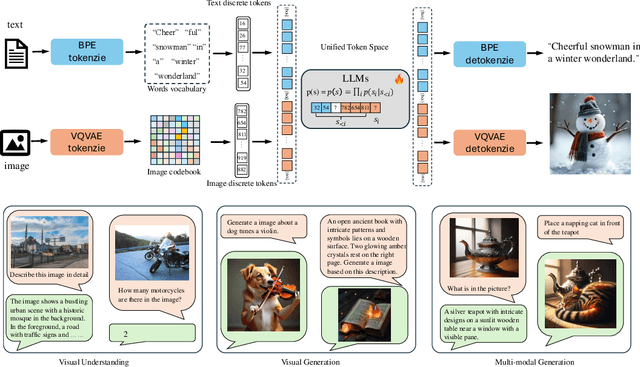
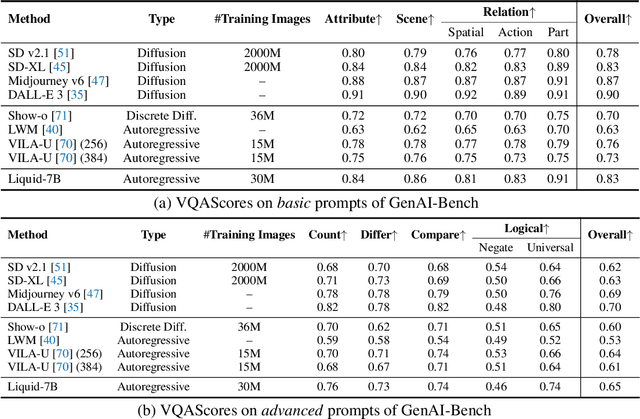
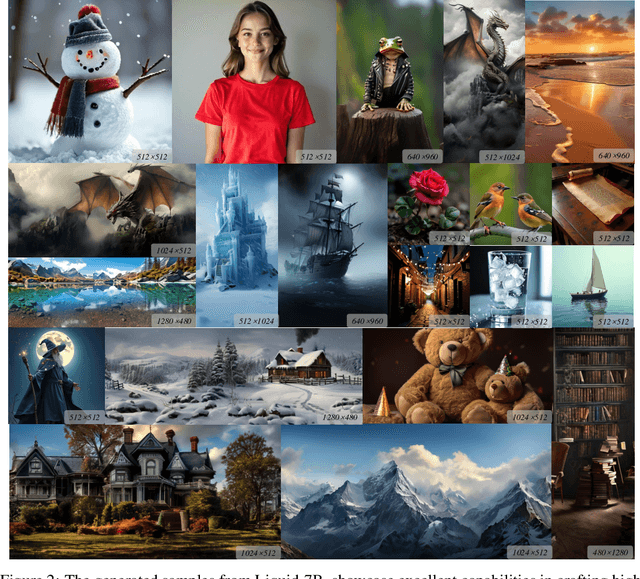
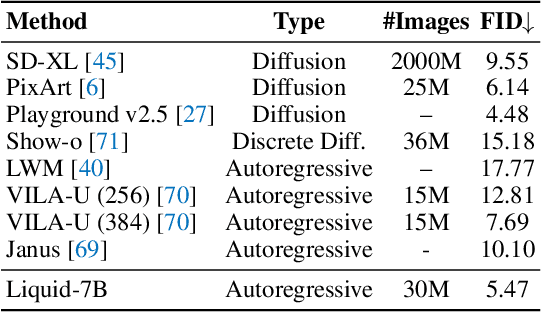
Abstract:We present Liquid, an auto-regressive generation paradigm that seamlessly integrates visual comprehension and generation by tokenizing images into discrete codes and learning these code embeddings alongside text tokens within a shared feature space for both vision and language. Unlike previous multimodal large language model (MLLM), Liquid achieves this integration using a single large language model (LLM), eliminating the need for external pretrained visual embeddings such as CLIP. For the first time, Liquid uncovers a scaling law that performance drop unavoidably brought by the unified training of visual and language tasks diminishes as the model size increases. Furthermore, the unified token space enables visual generation and comprehension tasks to mutually enhance each other, effectively removing the typical interference seen in earlier models. We show that existing LLMs can serve as strong foundations for Liquid, saving 100x in training costs while outperforming Chameleon in multimodal capabilities and maintaining language performance comparable to mainstream LLMs like LLAMA2. Liquid also outperforms models like SD v2.1 and SD-XL (FID of 5.47 on MJHQ-30K), excelling in both vision-language and text-only tasks. This work demonstrates that LLMs such as LLAMA3.2 and GEMMA2 are powerful multimodal generators, offering a scalable solution for enhancing both vision-language understanding and generation. The code and models will be released.
TokenFlow: Unified Image Tokenizer for Multimodal Understanding and Generation
Dec 04, 2024



Abstract:We present TokenFlow, a novel unified image tokenizer that bridges the long-standing gap between multimodal understanding and generation. Prior research attempt to employ a single reconstruction-targeted Vector Quantization (VQ) encoder for unifying these two tasks. We observe that understanding and generation require fundamentally different granularities of visual information. This leads to a critical trade-off, particularly compromising performance in multimodal understanding tasks. TokenFlow addresses this challenge through an innovative dual-codebook architecture that decouples semantic and pixel-level feature learning while maintaining their alignment via a shared mapping mechanism. This design enables direct access to both high-level semantic representations crucial for understanding tasks and fine-grained visual features essential for generation through shared indices. Our extensive experiments demonstrate TokenFlow's superiority across multiple dimensions. Leveraging TokenFlow, we demonstrate for the first time that discrete visual input can surpass LLaVA-1.5 13B in understanding performance, achieving a 7.2\% average improvement. For image reconstruction, we achieve a strong FID score of 0.63 at 384*384 resolution. Moreover, TokenFlow establishes state-of-the-art performance in autoregressive image generation with a GenEval score of 0.55 at 256*256 resolution, achieving comparable results to SDXL.
ChatSearch: a Dataset and a Generative Retrieval Model for General Conversational Image Retrieval
Oct 24, 2024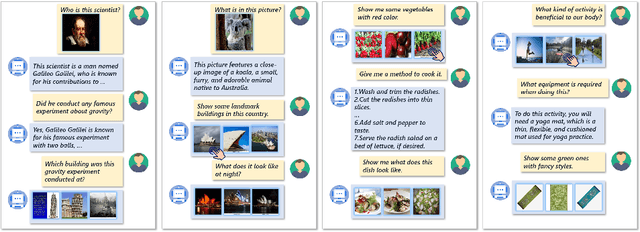
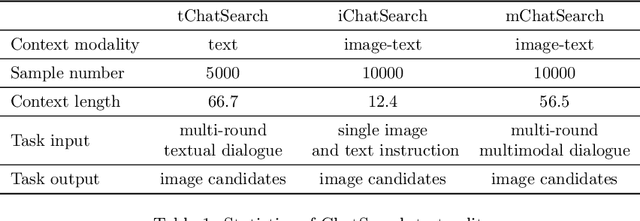
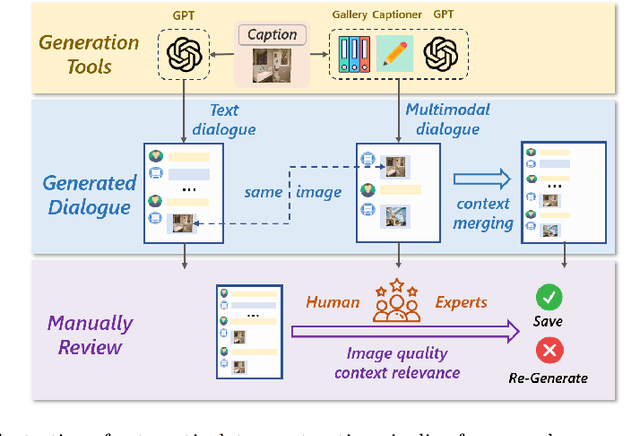

Abstract:In this paper, we investigate the task of general conversational image retrieval on open-domain images. The objective is to search for images based on interactive conversations between humans and computers. To advance this task, we curate a dataset called ChatSearch. This dataset includes a multi-round multimodal conversational context query for each target image, thereby requiring the retrieval system to find the accurate image from database. Simultaneously, we propose a generative retrieval model named ChatSearcher, which is trained end-to-end to accept/produce interleaved image-text inputs/outputs. ChatSearcher exhibits strong capability in reasoning with multimodal context and can leverage world knowledge to yield visual retrieval results. It demonstrates superior performance on the ChatSearch dataset and also achieves competitive results on other image retrieval tasks and visual conversation tasks. We anticipate that this work will inspire further research on interactive multimodal retrieval systems. Our dataset will be available at https://github.com/joez17/ChatSearch.
OmniTokenizer: A Joint Image-Video Tokenizer for Visual Generation
Jun 13, 2024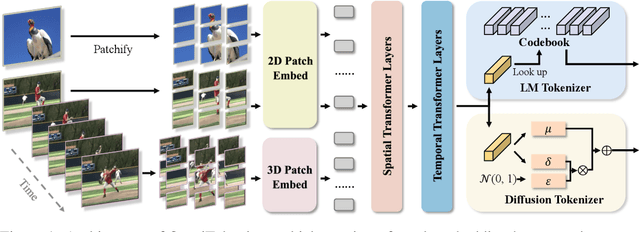
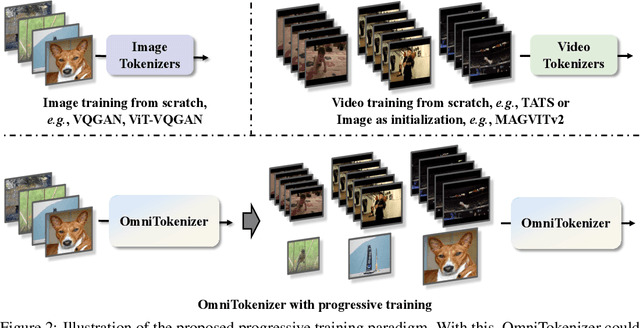
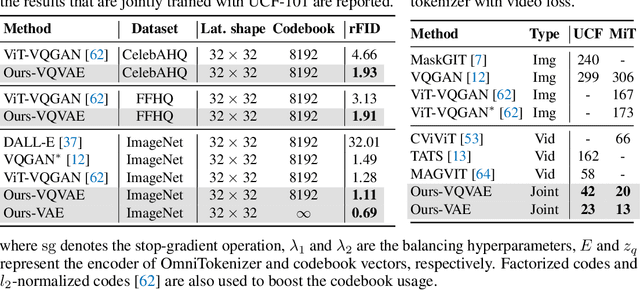
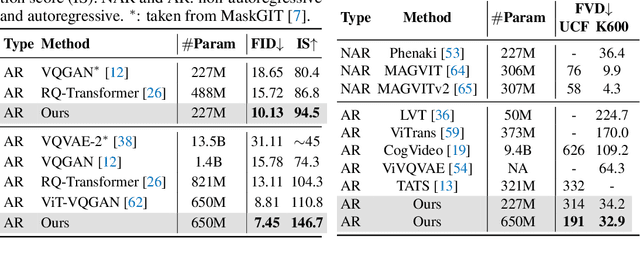
Abstract:Tokenizer, serving as a translator to map the intricate visual data into a compact latent space, lies at the core of visual generative models. Based on the finding that existing tokenizers are tailored to image or video inputs, this paper presents OmniTokenizer, a transformer-based tokenizer for joint image and video tokenization. OmniTokenizer is designed with a spatial-temporal decoupled architecture, which integrates window and causal attention for spatial and temporal modeling. To exploit the complementary nature of image and video data, we further propose a progressive training strategy, where OmniTokenizer is first trained on image data on a fixed resolution to develop the spatial encoding capacity and then jointly trained on image and video data on multiple resolutions to learn the temporal dynamics. OmniTokenizer, for the first time, handles both image and video inputs within a unified framework and proves the possibility of realizing their synergy. Extensive experiments demonstrate that OmniTokenizer achieves state-of-the-art (SOTA) reconstruction performance on various image and video datasets, e.g., 1.11 reconstruction FID on ImageNet and 42 reconstruction FVD on UCF-101, beating the previous SOTA methods by 13% and 26%, respectively. Additionally, we also show that when integrated with OmniTokenizer, both language model-based approaches and diffusion models can realize advanced visual synthesis performance, underscoring the superiority and versatility of our method. Code is available at https://github.com/FoundationVision/OmniTokenizer.
 Add to Chrome
Add to Chrome Add to Firefox
Add to Firefox Add to Edge
Add to Edge